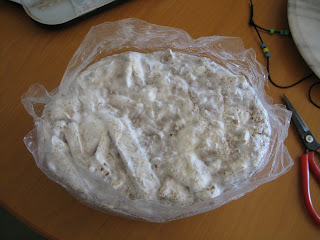If you buy any kind of mushroom kit online, except portabella, it will most likely come in the form of a 5lb block of wood chips grown through with mycelium. The reason for this is simple. Wood chips are easy to colonize for mushrooms, a nutritious food source, and a convenient medium for transfer. One of the best things about growing mushrooms on wood chips is that they can be fruited up to three times and then used to transfer mushrooms to a new substrate. In fact, it really doesn’t matter (for most mushrooms, that is*) whether you bought the block for transferring mycelium to a new medium or for producing mushrooms. It can first be fruited and then broken up and used as spawn.
Growing mushrooms on wood chips is pretty easy. First you need to match the wood with the preferences of the mushroom. Then you need to get the wood into the right form. Sawdust tends to be to fine and packs a bit too tightly for optimal mushroom growth. Large wood chips tend to have too much air flow for the mushrooms to grow well from one to the next. A good mixture of the two (about 20% chips to 80% sawdust or fine wood chips works best. If you have a chipper that grinds them fairly small but not quite sawdust, like I have, it works well as is. Just don’t use wood shavings from your pal’s wood shop. Even if they use the right kind of wood, the curled shape keeps the shavings from packing very well and the mushrooms don’t grow well on it.
The next step is to pasteurize the wood chips. You want to get the wood chips up to about 180 degrees F and leave them there for an hour to kill pathogens. Then you need to get mushrooms growing on it. Other wood chip spawn works quite well. You can also use stem butts or even plug spawn. Then grow it like you would any mushroom block. When it is ready, you fruit the block a few times and then break it up onto your next substrate. That can even be more wood chips.
Just realize that every time you transfer mycelium, you run the risk of contamination.



What a beautiful thing to behold all that white mycelium. Hey before you put your spawn into the woodchips it is helpful to pasturize the wood chip subsrate to promote the thermophilic bacteria which get the chips ready for colonization.
ReplyDelete...I imagine all the mycelium taking hold in the all the debris in Japan, it will begin the process of stabalizing slides and decomposing wood and oil...I hope they use mycelium to clean up
Oh, I knew I was forgetting a step. I'll add that. Paul Stamets talks about using spore mass slurry to "slurry bomb" disaster areas, allowing the mushrooms to clean up the mess and re-naturalize the area.
ReplyDeleteWhere do you order your mushroom spores from?
ReplyDeletePsilocybe azurescens or psilocybe cyanescens would be ideal on alder chips
ReplyDeleteWhat about hard woods for alcabenzi?
ReplyDelete